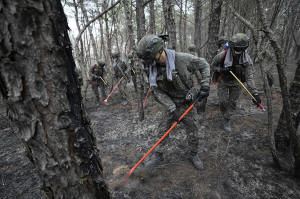South Korea's worst wildfires are now almost contained following rain
and cooler weather
[March 28, 2025]
By HYUNG-JIN KIM and KIM TONG-HYUNG
SEOUL, South Korea (AP) — The most destructive wildfires ever to hit
South Korea were almost contained, authorities announced Friday, after
rain and cooler temperatures helped fire crew put out the blazes that
have killed 28 people and razed vast swaths of land since last week.
In a televised briefing, Korea Forest Service chief Lim Sang-seop said
that all main fires at four of the hardest-hit areas in the southeast
have been fully contained.
The forest service’s website shows efforts to extinguish the wildfires
remain at only one place as of Friday afternoon. The government’s
disaster response team earlier said that wildfires at other sites have
been put out.
“As we've completed works to contain main fires, we're turning into a
system to deal with small fires,” Lim said. “There are still dangers of
breakouts of another wildfires so we won't loosen our vigilance and will
make all-out efforts to prevent them.”
The raging inferno, fueled by windy and dry conditions, has destroyed
thousands of houses, factories, vehicles and other structures since last
Friday, while mountains and hills were stripped to a carpet of
smoldering ashes. But light rain that began Thursday night and
subsequent cooler weather have helped fire-fighting efforts.
“Hazes have been diminished because of the rain last night, so that’s
favorable for securing visibility. Also temperatures are now lower than
the last few days, so things are very favorable to put out the
wildfires,” Lim said in an earlier briefing Friday.
Authorities mobilized about 9,000 people, 125 helicopters and hundreds
of other vehicles Friday to battle the wildfires.

Tens of thousands have fled their homes
Firefighters — many in their 60s, a reflection of one of the world’s
fastest-aging populations — navigated forests in yellow helmets and red
protective suits, spraying suppressants at flames that flickered near
their feet. Helicopters dropped buckets of water over hills that glowed
red in the night.
Residents hunkered down in temporary shelters in places like schools and
gyms, but the fire crept dangerously close to some of them too. A video
shared by one evacuee shows blazes approaching a school soccer field
under a sky choked with smoke.
“I just kept crying this morning,” said 79-year-old Seo Jae Tak, an
evacuee at a gym in Andong city, on Thursday. “When I went back
yesterday, the entire mountain had turned to ashes. It’s just
unbelievable, I can’t even put it into words. All I can do is cry.”
The wildfires have burned 47,860 hectares (118,265 acres) of land,
forced more than 30,000 people to flee their homes and injured 37 others
since last Friday. Officials said Friday that 8,000 residents remained
at temporary shelters.
[to top of second column]
|

South Korean army soldiers work to prevent the further spread of
wildfires in Uiseong, South Korea, Thursday, March 27, 2025. (AP
Photo/Ahn Young-joon)

Wake-up call to overhaul wildfire responses
While it's hard to link any one event to climate change, officials
and experts say that it is making wildfires more likely and more
severe. Scientists have already warned the warming atmosphere around
the world is driving ever more extreme weather events, including
deadly wildfires, flooding, droughts, hurricanes and heat waves that
are causing billions of dollars in damage every year.
“We must completely overhaul our wildfire response strategy in the
face of extreme climate conditions,” said Lee Cheol-woo, governor of
North Gyeongsang Province.
Lee noted that the past week has shown how wildfires can quickly
overwhelm the country's resources. He said he would request that the
government establish better evacuation guidelines, adopt more
powerful firefighting tools including aircraft equipped with water
cannons, and adopt other approaches to improve firefighting efforts
during nighttime hours.
“We don’t have the equipment for firefighting at night,” Lee said.
“In the night, firefighting is done solely with manual efforts, but
with the increased density of our forests compared to the past, it’s
difficult to manage with just that.”
The people killed were mostly in their 60s or older. They include a
pilot whose helicopter crashed during efforts to contain a fire
Wednesday and four firefighters and other workers who died earlier
after being trapped by fast-moving flames. Officials say older
people found it difficult to evacuate quickly but have not provided
details of the civilian dead.
In Uiseong, the fires damaged about 20 of the 30 structures at the
Gounsa temple complex, said to have been originally built in the 7th
century. Among them were two state-designated “treasures”: a
pavilion overlooking a stream that dates to 1668, and a Joseon
dynasty structure built in 1904 to mark the longevity of a king.
___
Associated Press video journalist Yong Jun Chang in Andong, South
Korea contributed to this report.
All contents © copyright 2025 Associated Press. All rights reserved
 |